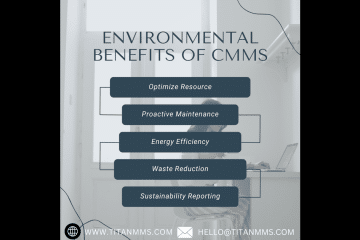Introduction
Maintenance operations are the backbone of any industrial setup. Ensuring that machinery and equipment are in top-notch condition is crucial for seamless operations and productivity. This is where Computerized Maintenance Management Systems (CMMS) come into play. But, in today’s fast-paced, tech-driven world, traditional CMMS is getting a significant upgrade through cloud-based solutions. Let’s dive into how cloud-based CMMS solutions are revolutionizing maintenance operations.
What is a Cloud-Based CMMS?
A Cloud-Based CMMS is a software solution that helps organizations manage their maintenance operations more efficiently by leveraging cloud technology. Unlike traditional CMMS, which are installed locally on company servers, cloud-based CMMS operates over the internet. This means you can access it from anywhere, at any time, using any device with internet connectivity.
Key Features of Cloud-Based CMMS
- Remote Accessibility: Access the system from any location.
- Scalability: Easily expand or reduce capabilities as needed.
- Automatic Updates: Always have the latest features and security updates without manual intervention.
Benefits of Cloud-Based CMMS Solutions
Cost-Effectiveness
Traditional CMMS often require substantial upfront costs for hardware and software licenses. Cloud-based solutions, on the other hand, operate on a subscription model, reducing initial investments and allowing for better budgeting.
Accessibility and Mobility
With a cloud-based CMMS, maintenance teams can access data and manage tasks from their mobile devices, whether they’re on-site or on the move. This flexibility boosts productivity and ensures timely maintenance actions.
Scalability
As your business grows, so do your maintenance needs. Cloud-based CMMS can scale effortlessly to accommodate more users, assets, and locations without significant additional costs.
Automatic Updates
Forget about manually updating software. Cloud-based CMMS solutions automatically provide updates, ensuring that you always have the latest features and security enhancements.
Enhancing Maintenance Operations
Streamlining Work Orders
Creating, assigning, and tracking work orders becomes seamless with cloud-based CMMS. Technicians can receive alerts and updates in real-time, ensuring that no task falls through the cracks.
Preventive Maintenance Scheduling
Preventive maintenance is essential to avoid unexpected equipment failures. Cloud-based CMMS can automatically schedule and remind teams of upcoming maintenance tasks, significantly reducing the risk of unplanned downtime.
Asset Management
Keeping track of all assets, their conditions, and maintenance history is simplified. This ensures that each piece of equipment gets the attention it needs to operate efficiently.
Inventory Control
Efficiently managing spare parts and supplies ensures that necessary items are always in stock, reducing delays and avoiding overstocking.
Improving Efficiency and Productivity
Real-Time Data and Analytics
Access to real-time data allows for more informed decision-making. Analytics can identify trends and potential issues before they escalate, enabling proactive maintenance.
Improved Communication and Collaboration
With all information centralized and accessible, communication between team members and departments improves. Collaborative features in cloud-based CMMS facilitate better coordination and information sharing.
Reduced Downtime
By predicting and preventing potential failures, cloud-based CMMS minimizes downtime, keeping operations running smoothly and efficiently.
Cost Savings and ROI
Lower Initial Investment
Cloud-based solutions eliminate the need for expensive hardware and software purchases. The subscription model allows for predictable and manageable expenses.
Reduction in Maintenance Costs
Proactive maintenance and efficient resource management lead to fewer breakdowns and repairs, lowering overall maintenance costs.
Long-Term Financial Benefits
Over time, the efficiency gains and cost savings from a cloud-based CMMS translate into a significant return on investment (ROI).
Case Studies and Real-World Examples
Many companies across various industries have successfully implemented cloud-based CMMS solutions, seeing significant improvements in their maintenance operations. For instance, a manufacturing company might report a 20% reduction in downtime, while a healthcare facility could see enhanced compliance with regulatory standards.
Integration with Other Systems
Compatibility with ERP and IoT
A major advantage of cloud-based CMMS is its ability to integrate seamlessly with other systems like Enterprise Resource Planning (ERP) and Internet of Things (IoT) devices. This integration provides a more comprehensive view of operations, enhancing decision-making and operational efficiency.
Security and Reliability
Data Protection Measures
Cloud-based CMMS providers invest heavily in security measures, including encryption, regular backups, and stringent access controls, ensuring that your data is safe.
Ensuring System Reliability
With robust infrastructure and redundancy mechanisms, cloud-based CMMS solutions offer high availability and reliability, ensuring that maintenance operations are never interrupted.
Customization and Flexibility
Tailoring the System to Specific Needs
Cloud-based CMMS solutions can be customized to meet the unique requirements of different industries and organizations, providing tailored features and workflows.
Adapting to Changing Business Requirements
As businesses evolve, their maintenance needs may change. Cloud-based CMMS can adapt to these changes quickly, offering flexibility that traditional systems cannot match.
User-Friendly Interface
Ease of Use and Training
A user-friendly interface makes it easier for staff to learn and use the system, increasing adoption rates and reducing training time.
Adoption Rate Among Employees
The intuitive design and mobile access of cloud-based CMMS lead to higher adoption rates among employees, ensuring that the system is used to its full potential.
Environmental Impact
Sustainable Maintenance Practices
Cloud-based CMMS supports sustainable practices by optimizing maintenance schedules and reducing unnecessary resource usage.
Reducing Waste and Energy Consumption
Efficient maintenance operations help reduce waste and energy consumption, contributing to a smaller environmental footprint.
Challenges and Considerations
Potential Drawbacks
While cloud-based CMMS offers numerous benefits, potential drawbacks include dependency on internet connectivity and concerns about data privacy.
Tips for Successful Implementation
To ensure successful implementation, it’s crucial to have a clear plan, involve key stakeholders, and provide adequate training and support to users.
Future Trends in Cloud-Based CMMS
Emerging Technologies
Technologies like Artificial Intelligence (AI), Machine Learning (ML), and Augmented Reality (AR) are set to further enhance cloud-based CMMS capabilities, offering predictive maintenance and advanced diagnostics.
Predictions for the Next Decade
In the coming years, we can expect cloud-based CMMS solutions to become even more integrated, intelligent, and indispensable to maintenance operations across all industries.
Conclusion
Cloud-based CMMS solutions are transforming maintenance operations by offering enhanced efficiency, cost savings, and flexibility. By leveraging the power of the cloud, businesses can streamline their maintenance processes, improve asset management, and achieve significant long-term benefits. Embracing this technology is a strategic move towards more efficient, reliable, and sustainable maintenance operations.
FAQs
Q1. What is the main advantage of a cloud-based CMMS over traditional CMMS?
Ans. The primary advantage is accessibility. Cloud-based CMMS can be accessed from anywhere with an internet connection, providing greater flexibility and mobility compared to traditional, on-premise CMMS.
Q2. How does a cloud-based CMMS help in reducing maintenance costs?
Ans. It helps by streamlining maintenance processes, enabling preventive maintenance, improving inventory control, and reducing downtime, all of which contribute to lower overall maintenance costs.
Q3. Are cloud-based CMMS solutions secure?
Ans. Yes, they typically offer robust security measures, including data encryption, regular backups, and stringent access controls to protect sensitive information.
Q4. Can cloud-based CMMS integrate with other business systems?
Ans. Absolutely. Cloud-based CMMS solutions can integrate with ERP systems, IoT devices, and other business applications to provide a comprehensive view of operations and enhance overall efficiency
Q5. What future trends can we expect in cloud-based CMMS?
Ans. Future trends include the integration of AI, ML, and AR to offer predictive maintenance, advanced diagnostics, and more intuitive user experiences, making maintenance operations even more efficient and proactive.




0 Comments